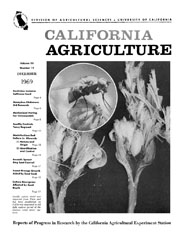All Issues











Volume 23, Number 12














|
|||
|
|||

Cover:
Seedfly (photo inset) was imported from Paris and has been established on California rangeland to aid fight against spread of the noxious weed tansy ragwort.

Cover:
Citrus seedlings being examined by Ray Copeland, Superintendent at the Lindcow Field Station, Tulare County, are part of the station’s extensive research toward development of new, disease resistant varieties for San Joaquin Valley plantings.

Cover:
Early feeding (2% to 3 weeks ahead of bloom) with a drivert sugar and pollen supplement resulted in a rapid increase in honey bee colony population, and greatly increased pollination of almond blossoms., Heavy pollen collections as shown in inset photo (resulting from supplemental feeding) were from 44 to 97 per cent greater than control colonies.

Cover:
Remarkable resolution and three-dimensional clarity of the new scanning electron
microscopes now available to University researchers are visible in this enlargement of electron photomicrograph of male genitalia. of a parasite of the housefly.

Cover:
Test plots for chemical “mowing” of turfgrass with fluorine compounds ut U.C. Davis.

Cover:
Researchers investigate potential of fingerling rainbow trout for control of snow mosquito larvae at South I,ake Tahoe.

Dust bags for horn fly control.
Cover:
Good control of horn flies was obtained at this Plumas County ranch with use of insecticidal dust bags seen hanging across gate to water, salt lick and bedding area.

Insect-proofing during building construction.
Cover:
Ventura TownHouse, an apartment complex consisting of a 7-story concrete building (above) and surrounding frame house duplexes (below) was all insect- proofed at the time of construction.

Cover:
Grape leaf folder moth to right and parasitic wasp, Macrocentrus, above, depositing eggs in larvae of grape leaf folder.

Cover:
A severe bee kill resulted from insecticide applications to a safflower field two miles away during experiments with supplemental feeding of honey bee colonies in a Fresno County alfalfa seed field.

Cover:
Multiple fruits from higher application rates (250 ppm) of the plant growth regulator Ethrel were one: result in tests at University of California, Davis, with cucumbers for pickling.
December 1969
Volume 23, Number 12 |
|||
|
University of California, 1301 S. 46th St., Bldg. 478 Richmond, CA
|